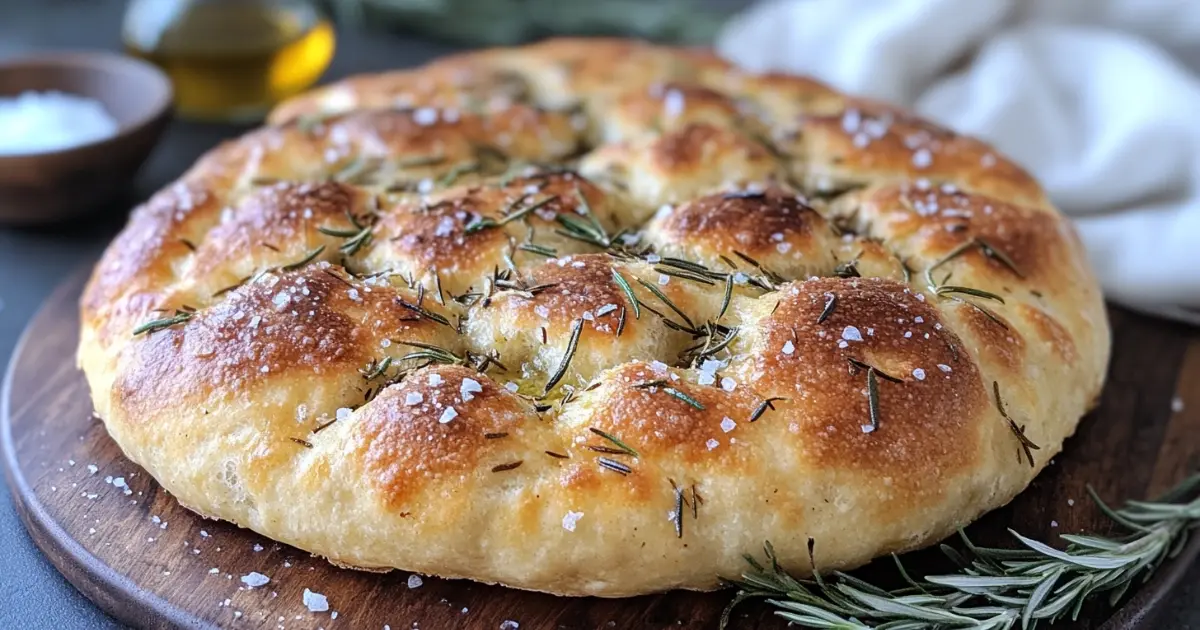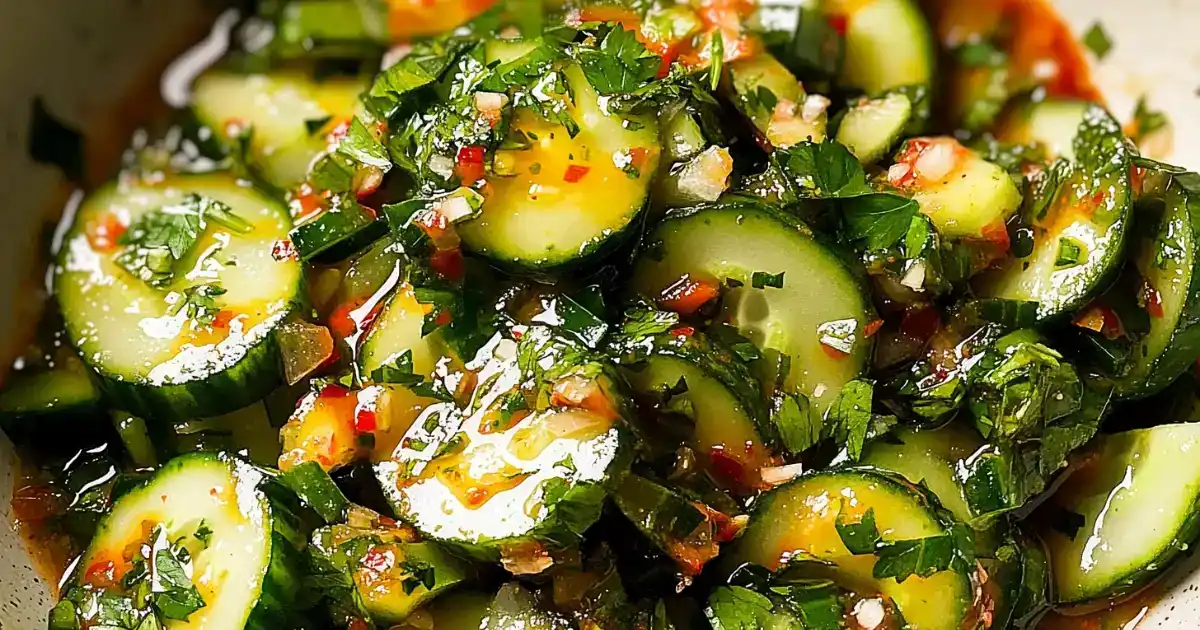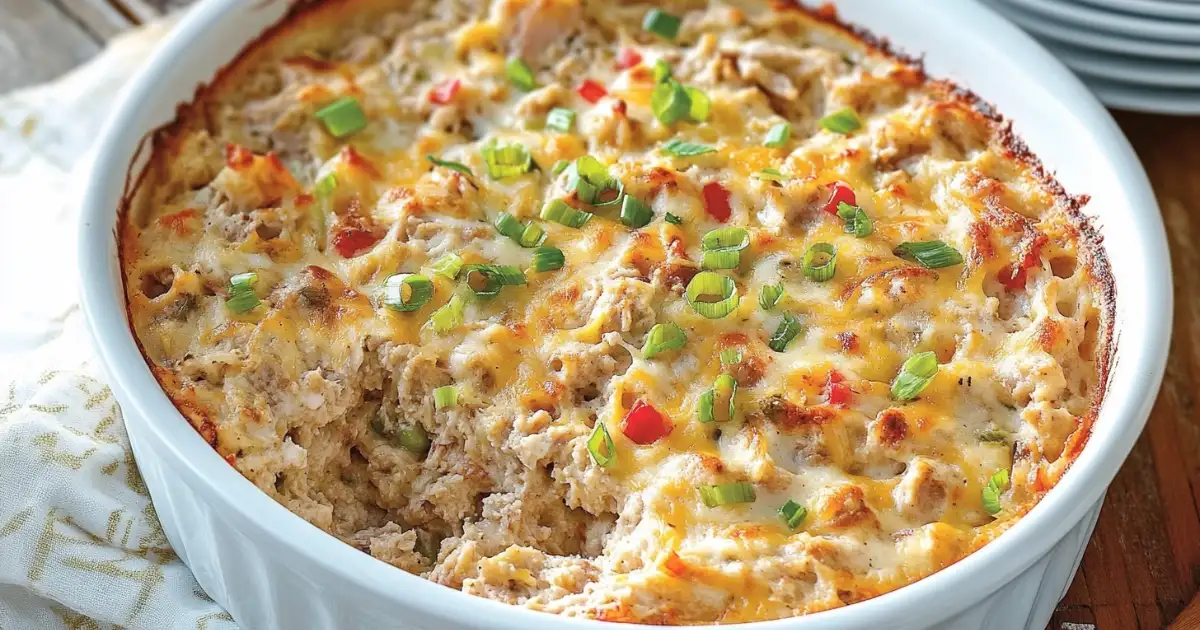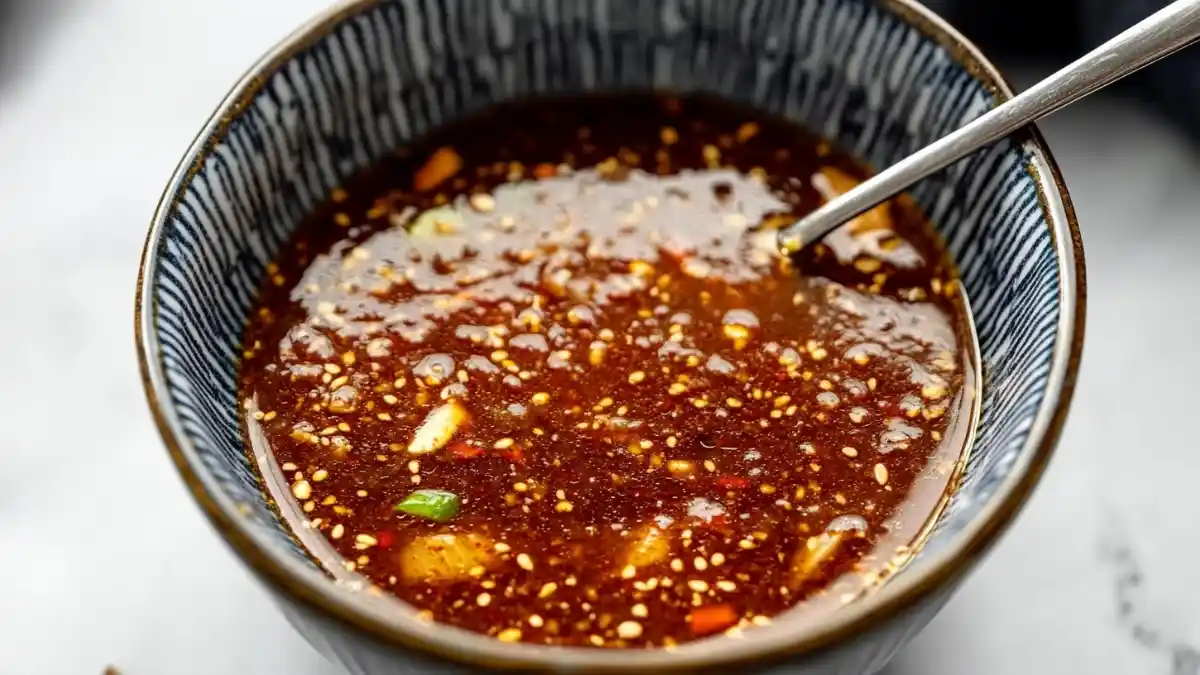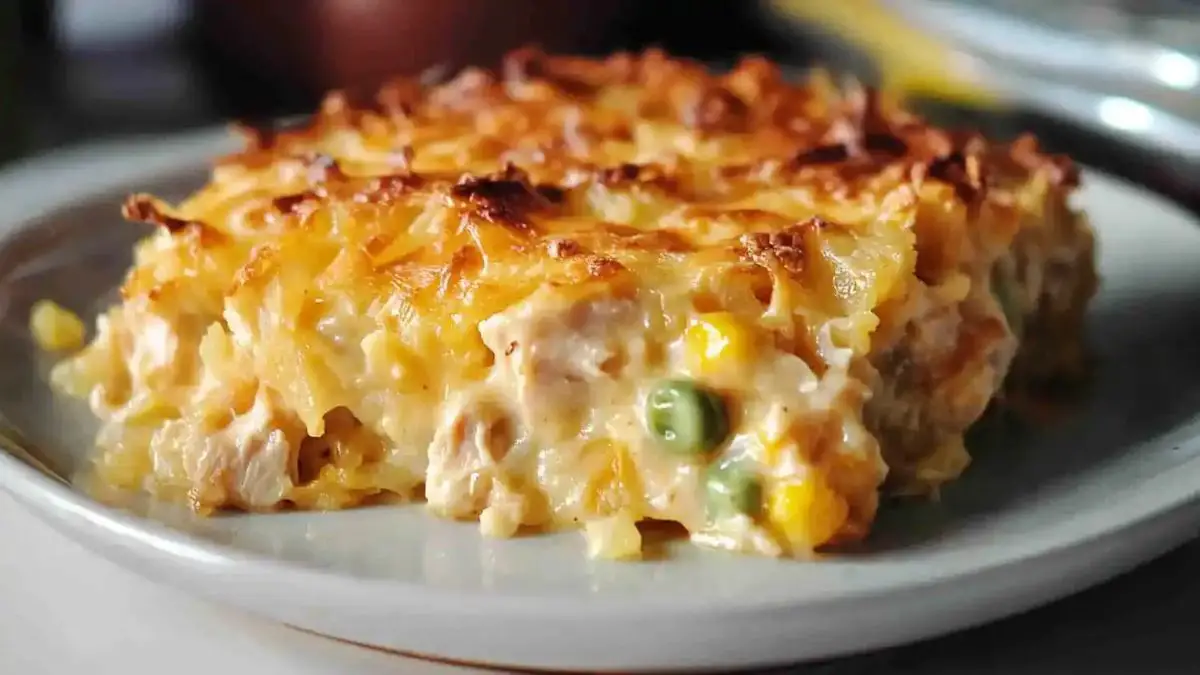Sourdough focaccia is a delightful bread that blends crunchy edges with a soft interior. If you enjoy tangy flavors, this recipe will be a new favorite. It starts with a sourdough starter and uses bread flour for a chewy crumb. You can top it with olive oil and fresh rosemary, or you can get creative with other ingredients. The dough rises slowly, which helps build wonderful taste and texture.
This approach works well for beginners who are starting out with sourdough, and it also satisfies experienced bakers. Ready to bake sourdough focaccia? Let’s walk through each step so you can create a loaf that tastes amazing and looks good, too.
Key Takeaways
- Great Taste and Texture: This focaccia dough gives you a slightly tangy flavor and a soft bite.
- Flexible Toppings: Add fresh rosemary, sliced onions, or olives on top of the dough. You can try this recipe multiple ways to find your favorite topping combination.
- Approachable for Beginners: If you are new to sourdough baking, this recipe is easy to follow and uses simple ingredients.
- Slow Rise for Flavor: The dough rise is longer than a quick yeast bread. This extra time develops the trademark sourdough flavor.
Why You’ll Love This Recipe
You will love this simple sourdough focaccia bread recipe because it brings you a mix of soft interior, crisp exterior, and a gentle tang from your active sourdough starter. Even if you’re new to sourdough, you’ll find that the steps are clear and straightforward. The dough may take some time to rise, but that extra effort pays off with each slice. Plus, the aroma that comes from the oven when you bake sourdough focaccia is outstanding.
There’s also the fun of personalizing your toppings. A classic choice is fresh rosemary. You could use a generous drizzle of olive oil, or even add sliced tomatoes on top of the dough. The possibilities are many. Once you remove the focaccia from the baking pan, you’ll notice how easily it comes together: golden edges and a tender crumb. It’s a perfect bread for dipping in olive oil, pairing with soup, or serving as a side to any main dish.
Another reason to love this recipe is that it suits different schedules. You can let the dough rise overnight if you want maximum taste, or you can follow the same-day approach if you want fresh focaccia in fewer hours. Let’s explore how to make sourdough focaccia step by step.
Ingredients for Sourdough Focaccia Recipe
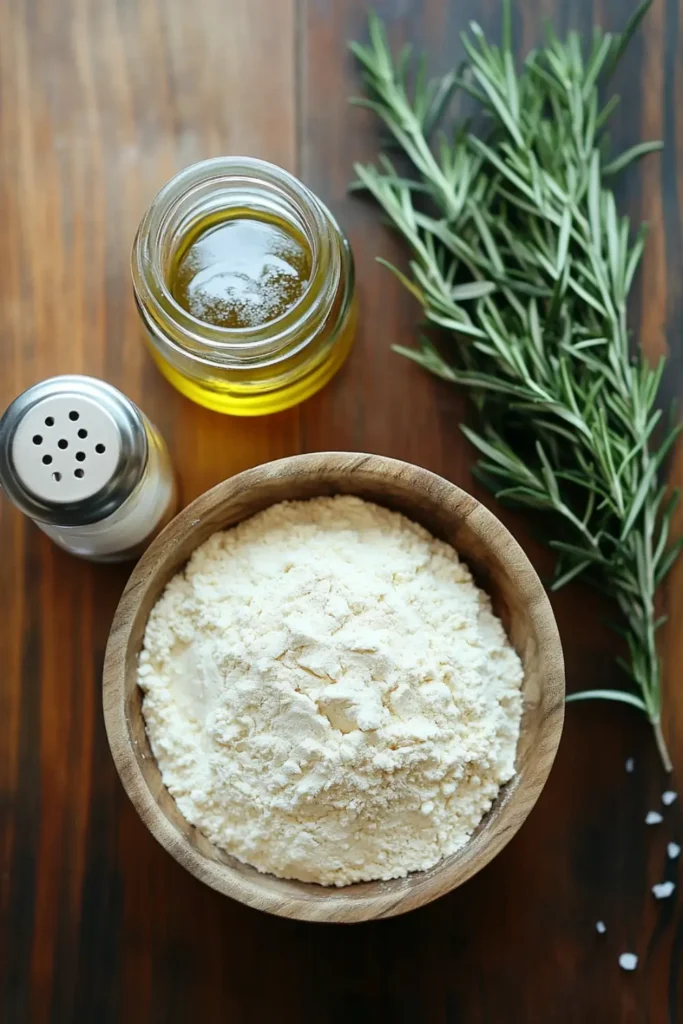
Below are the essential items you’ll need. Feel free to adjust them based on your preferences or dietary needs:
- Bread Flour (Around 500 grams or 4 cups): Bread flour is best for this recipe since it has enough protein to produce a chewy, airy crumb. If you want a lighter feel, you can mix all-purpose flour into the blend. Some bakers use King Arthur bread flour for this recipe.
- Active Sourdough Starter (About 100 grams or ½ cup): A ripe sourdough starter is key here. Make your own sourdough starter if you don’t have one. You need a healthy starter for this focaccia dough.
- Warm Water (Approximately 350–370 grams or 1½ cups): Room temperature water works if your kitchen is warm. Otherwise, slightly warmer water can help the dough rise well.
- Olive Oil (3 tablespoons plus extra): Olive oil brings a rich flavor. You also want extra oil for greasing the bottom of the pan and drizzling on top of the dough.
- Salt (About 10–12 grams or 2 teaspoons): Salt balances the tangy taste of sourdough.
- Optional Fresh Rosemary (2–3 sprigs): Rosemary is a classic topping that pairs well with sourdough bread. You can also try other herbs or sliced veggies.
- Optional Additional Toppings: Consider thinly sliced onions, cherry tomatoes, grated cheese, or olives. Focaccia toppings can be as simple or elaborate as you prefer.
How to Make Sourdough Focaccia Recipe
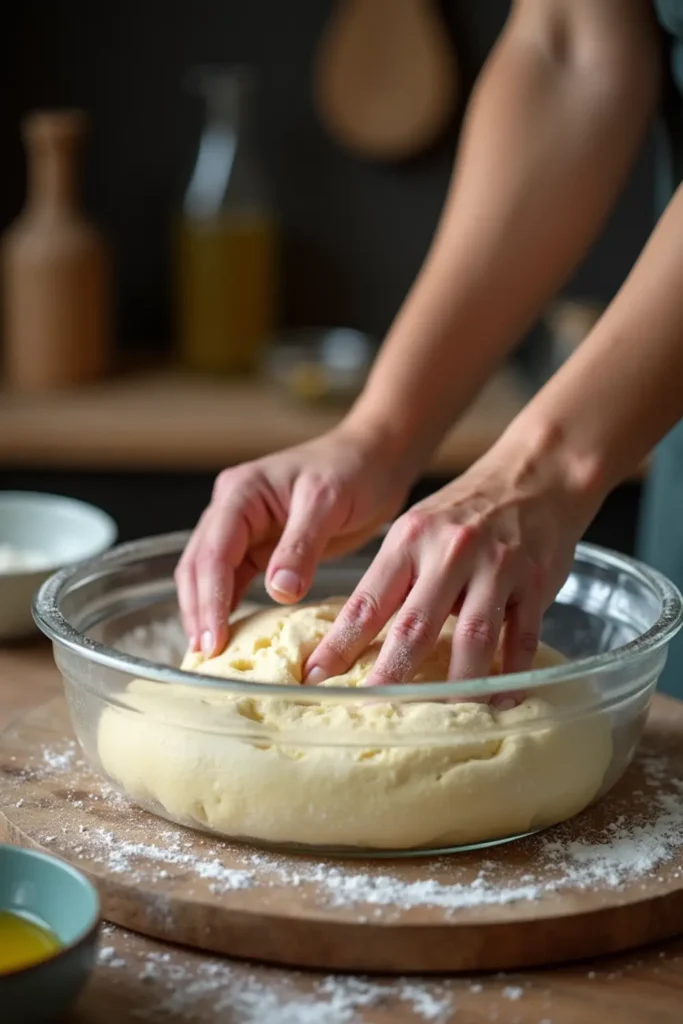
Follow these instructions step by step to get a bread that has plenty of flavor and good texture. This is one of my favorite sourdough recipes because it’s simple to prepare yet offers a great payoff.
1. Feed Your Starter (If Needed)
- If your sourdough starter hasn’t been fed lately, feed it several hours before mixing the dough.
- Check that it becomes active. You want it bubbly and doubled in size. This step is important if you need a sourdough starter that’s at its peak.
2. Mix the Dough
- In a large bowl, combine the flour, water, and sourdough starter. Stir until the flour is well-hydrated.
- Let the dough rest for about 20–30 minutes. This brief pause helps the gluten formation and improves texture when you make focaccia.
3. Add Salt
- After the initial rest, scatter salt on top of the dough.
- Pinch the salt into the dough until it is distributed evenly.
- Drizzle about 1 tablespoon of olive oil into the mixture for added softness.
4. Stretch and Fold
- Over the next hour, do several rounds of stretch and fold. This step strengthens the gluten without kneading.
- To stretch and fold, grab one edge of the dough, pull it upward, and fold it back over the center. Turn the bowl and repeat about 4–6 times per round.
- Allow the dough to rest for 20–30 minutes between each round. By the end, the focaccia dough should feel smoother and more elastic.
5. Bulk Fermentation (First Rise)
- Once you’ve finished the stretch and fold process, cover the bowl and let the dough rise at room temperature.
- The time for this dough rise can vary. At moderate room temperature, it can take 4–6 hours. For a slower process that boosts flavor, you can place the dough in the fridge overnight.
- You’re looking for the dough to increase by about 50–75% in volume. It doesn’t need to double, but it should appear puffier.
6. Prepare the Pan
- Generously coat the bottom of the pan with olive oil. A standard 9×13-inch pan or a similar size works well.
- Oil helps crisp the edges and prevents sticking.
7. Shape the Focaccia
- Gently transfer the dough to the prepared pan. Use your hands to press it out toward the corners, but do not force it. If the dough shrinks back, let it rest for 10 minutes and then continue.
- The goal is to create an even layer of dough.
8. Second Rise
- Cover the pan with plastic wrap or a damp cloth.
- Let the dough rise again for about 2–3 hours, or until it appears bubbly on the surface and has spread fully in the pan. This extended period helps you get a better sourdough flavor.
9. Dimple the Dough
- Once the dough has risen, drizzle about 2 more tablespoons of olive oil on top of the dough.
- Use your fingertips to gently press down and create dimples throughout the surface. This is the classic focaccia look.
- Sprinkle fresh rosemary or other chosen toppings. Sea salt flakes also work well here.
10. Preheat Your Oven
- Preheat to 425°F (220°C).
- Let the dough rest while the oven warms up, so it stays airy and light.
11. Ready to Bake
- Place the pan on the middle rack of your oven. Bake the focaccia for around 20–25 minutes, or until it develops a golden top and crisp edges.
- Keep an eye on it, as bake times may differ based on your oven’s heating.
12. Remove the Focaccia and Let It Cool
- When it’s done, remove the focaccia from the oven.
- Carefully lift it from the pan and let the focaccia cool for at least 10 minutes on a wire rack. This helps retain a crisp crust.
Serving and Storage Tips
- Serving Suggestions: Cut the focaccia into squares or strips. Enjoy it on its own or with dips like olive oil and balsamic vinegar. It’s also a perfect partner for soups, salads, or pasta dishes. If you like sandwiches, you can slice it horizontally and fill it with roasted veggies, cheese, or grilled chicken.
- Storage: If you have leftover sourdough focaccia, keep it in a sealed bag or airtight container at room temperature for up to two days. For longer storage, wrap it tightly and freeze it. Thaw it at room temperature and warm it in the oven for a few minutes before serving.
- Reheating: To revive your focaccia, place it in a preheated oven at 350°F (175°C) for around 5–8 minutes. It should crisp up again and taste fresh.
USDA Food Safety and Inspection Service: This resource provides comprehensive guidelines on safe food handling, including proper storage and cooking temperatures to prevent foodborne illnesses.
Helpful Notes
- Use Bread Flour: Bread flour for this recipe is recommended because it has the protein level needed to support the structure of your dough. If you prefer a lighter texture, combine bread flour with some all-purpose flour.
- Adjust Water as Needed: Flour brands differ in how they absorb moisture. If the dough feels too stiff, add a little more water. If it’s too wet, sprinkle in a bit more flour.
- Handling Sticky Dough: Sourdough focaccia dough can be sticky at first. Lightly oil your hands or use water on your fingers during stretch and fold to manage this.
- Timing is Flexible: Sourdough doesn’t always follow a strict clock. Warmer conditions can quicken the rise, while cooler conditions slow it down. If you like a stronger sourdough flavor, extend the fermentation by placing the dough in the fridge.
- Experiment with Toppings: Focaccia toppings are a huge part of its character. Besides rosemary, add thinly sliced red onions, cherry tomatoes, olives, or cheese. You can even experiment with a sweet variation, like topping the dough with cinnamon and sugar for a cinnamon roll sourdough focaccia twist.
- Check the Bottom of the Pan: Make sure your pan is well-greased to keep the dough from sticking. This also helps create a crisp underside.
- Starter for This Recipe: A healthy starter is important. If your starter is sluggish, your dough might not rise properly. Feed it a few times if needed.
- Practice Makes Perfect: If you’re new to sourdough, don’t worry if your first loaf doesn’t come out as planned. Each attempt teaches you more about how your starter reacts. Focus on simple changes, like adjusting water or rise time. Over time, you’ll get better sourdough results.
- Enjoy the Process: Sourdough baking can be a relaxing activity. Pay attention to how the dough feels, watch the bubbles form, and appreciate the aroma that fills your kitchen.
- Focaccia Variations: If you love sourdough, you might want to try other recipes like a simple sourdough focaccia bread with extra garlic or a sourdough pizza made with leftover dough. The steps are similar but with different shaping and toppings.
- Making This Focaccia During Busy Days: If you don’t have all day, try a same-day approach by letting the dough rise at a slightly warmer spot. That can shorten the bulk fermentation and still produce a great bread.
- Followed the Recipe? If you’ve followed the recipe and still want a stronger tang, extend the bulk rise or use less starter for a slower ferment. Each small change can affect flavor.
Conclusion
Sourdough focaccia is a wonderful bread recipe to try if you love sourdough flavor but want something easy and delicious. Its crisp surface, soft crumb, and olive oil finish suit many meals. Plus, it is straightforward, even for those who are making sourdough bread for the first time. The extra time spent waiting for the dough rise helps you build that signature sourdough taste.
Once you bake sourdough focaccia, you’ll discover it pairs with a wide range of foods. It also stores well and reheats nicely, so it’s a useful bread to have on hand. Feel free to customize the toppings: fresh rosemary, roasted garlic, or a sprinkle of cheese. If you’re looking for a recipe to try at home, this sourdough focaccia recipe is perfect. It’s easy to understand, and it produces fantastic results. Make this recipe today and enjoy fresh, homemade bread in your kitchen.
________________________________
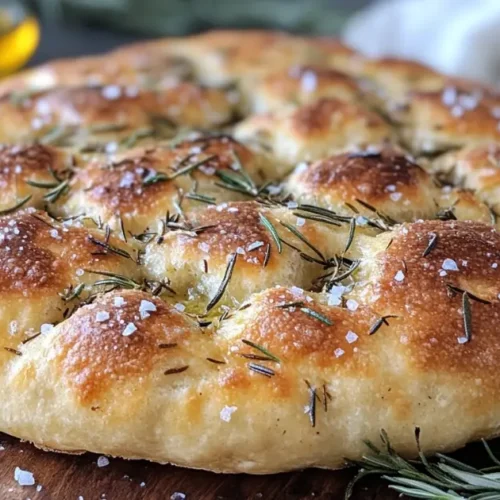
Sourdough foccacia recipe
Ingredients
- Bread Flour – 500g (4 cups)
- Active Sourdough Starter – 100g (½ cup)
- Warm Water – 350-370g (1½ cups)
- Olive Oil – 3 tbsp (plus extra for greasing)
- Salt – 10-12g (2 tsp)
- Fresh Rosemary – 2-3 sprigs (optional)
- Additional Toppings – Sliced onions cherry tomatoes, cheese, or olives (optional)
Instructions
Step 1: Feed Your Starter (If Needed)
- If your sourdough starter hasn’t been fed lately, feed it several hours before mixing the dough.
- Check that it becomes active. You want it bubbly and doubled in size. This step is important if you need a sourdough starter that’s at its peak.
Step 2: Mix the Dough
- In a large bowl, combine the flour, water, and sourdough starter. Stir until the flour is well-hydrated.
- Let the dough rest for about 20–30 minutes. This brief pause helps the gluten formation and improves texture when you make focaccia.
Step 3: Add Salt
- After the initial rest, scatter salt on top of the dough.
- Pinch the salt into the dough until it is distributed evenly.
- Drizzle about 1 tablespoon of olive oil into the mixture for added softness.
Step 4: Stretch and Fold
- Over the next hour, do several rounds of stretch and fold. This step strengthens the gluten without kneading.
- To stretch and fold, grab one edge of the dough, pull it upward, and fold it back over the center. Turn the bowl and repeat about 4–6 times per round.
- Allow the dough to rest for 20–30 minutes between each round. By the end, the focaccia dough should feel smoother and more elastic.
Step 5: Bulk Fermentation (First Rise)
- Once you’ve finished the stretch and fold process, cover the bowl and let the dough rise at room temperature.
- The time for this dough rise can vary. At moderate room temperature, it can take 4–6 hours. For a slower process that boosts flavor, you can place the dough in the fridge overnight.
- You’re looking for the dough to increase by about 50–75% in volume. It doesn’t need to double, but it should appear puffier.
Step 6: Prepare the Pan
- Generously coat the bottom of the pan with olive oil. A standard 9×13-inch pan or a similar size works well.
- Oil helps crisp the edges and prevents sticking.
Step 7: Shape the Focaccia
- Gently transfer the dough to the prepared pan. Use your hands to press it out toward the corners, but do not force it. If the dough shrinks back, let it rest for 10 minutes and then continue.
- The goal is to create an even layer of dough.
Step 8: Second Rise
- Cover the pan with plastic wrap or a damp cloth.
- Let the dough rise again for about 2–3 hours, or until it appears bubbly on the surface and has spread fully in the pan. This extended period helps you get a better sourdough flavor.
Step 9: Dimple the Dough
- Once the dough has risen, drizzle about 2 more tablespoons of olive oil on top of the dough.
- Use your fingertips to gently press down and create dimples throughout the surface. This is the classic focaccia look.
- Sprinkle fresh rosemary or other chosen toppings. Sea salt flakes also work well here.
Step 10: Preheat Your Oven
- Preheat to 425°F (220°C).
- Let the dough rest while the oven warms up, so it stays airy and light.
Step 11: Ready to Bake
- Place the pan on the middle rack of your oven. Bake the focaccia for around 20–25 minutes, or until it develops a golden top and crisp edges.
- Keep an eye on it, as bake times may differ based on your oven’s heating.
Step 12: Remove the Focaccia and Let It Cool
- When it’s done, remove the focaccia from the oven.
- Carefully lift it from the pan and let the focaccia cool for at least 10 minutes on a wire rack. This helps retain a crisp crust.
Step 13: Tried this Sourdough foccacia recipe?
- If you make this, I’d love to hear from you! Scroll down to rate this recipe and leave a quick comment. Your feedback helps others and supports my little website—thank you so much! 🙌💛
Video
Notes
- Calories: ~200 kcal
- Fat: ~7 g
- Protein: ~6 g
- Carbohydrates: ~28 g
- Fiber: ~2 g
- Sugar: ~1 g
- Sodium: ~300 mg
Explore More Delicious Recipes
If you enjoyed diving into the Sourdough Focaccia recipe, why not explore more delightful dishes from our collection? Here are some must-try recipes to elevate your cooking adventures:
- Broccoli Manchurian Recipe
- Agedashi Tofu Air Fryer Recipe
- Crescent Roll Pizza Recipe
- Honey Hot Chicken Tenders
- Cottage Cheese Buffalo Chicken Dip
Explore these recipes today to bring more exciting flavors to your table and make every meal memorable!
FAQs
1. How do I know when my sourdough starter is ready to use for focaccia?
When your sourdough starter is active and bubbly, it usually doubles in volume within 4–6 hours after feeding. This indicates it’s ready to help your focaccia dough rise. An active starter ensures the bread develops a light, airy texture and that signature tangy flavor.
2. Can I use all-purpose flour instead of bread flour for this recipe?
Yes, you can use all-purpose flour. However, bread flour for this recipe is recommended since it has a higher protein content, which supports better gluten development. If you only have all-purpose flour, consider combining it with some whole wheat flour or adding a bit more stretch and fold time to achieve a similar structure.
3. What is the best way to store leftover sourdough focaccia?
Place leftover sourdough focaccia in an airtight container or resealable bag. Keep it at room temperature for up to two days. To store it longer, freeze it. Wrap individual slices in plastic wrap or foil, then place them in a freezer-safe bag. Reheat in a 350°F (175°C) oven for a few minutes to restore its crisp exterior.
4. Why is my focaccia dough sticky, and how can I fix it?
Sourdough focaccia dough can feel sticky at first, which is normal because of the higher hydration. Lightly oil your hands or use water on your fingers during stretch and fold to manage it. If it’s excessively sticky, add a small amount of flour in gradual increments. Avoid adding too much flour at once, as this can make the loaf dense.
5. Can I let the dough rise overnight in the refrigerator?
Yes. An overnight rise in the fridge allows more complex flavors to develop in your sourdough focaccia bread. After mixing and performing the stretch and fold steps, cover the dough and refrigerate it. The cooler temperature slows fermentation, resulting in a more pronounced sourdough taste and a light, airy crumb the following day.

